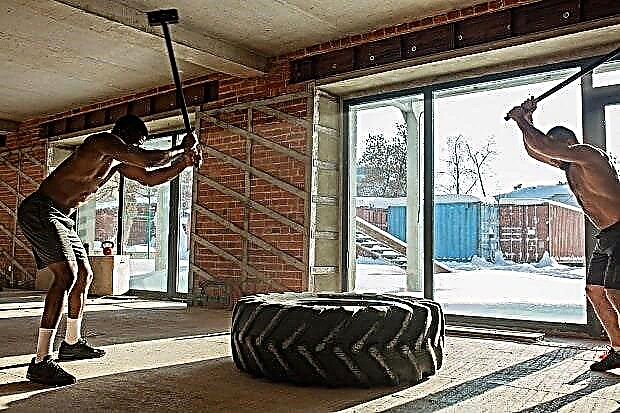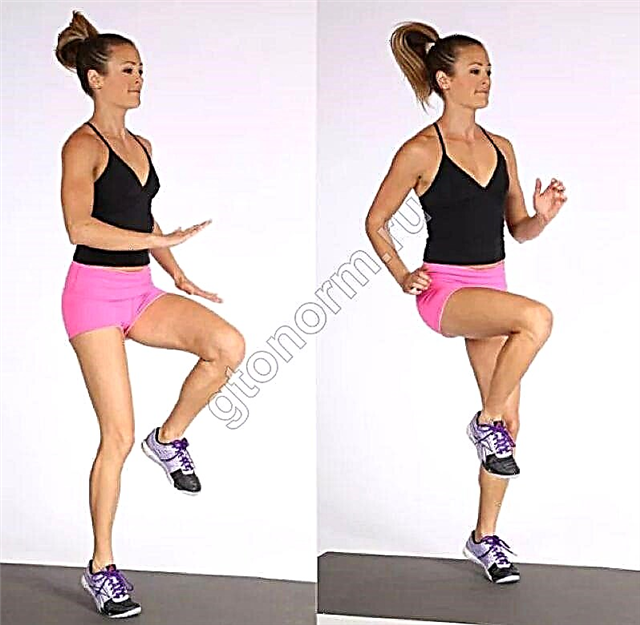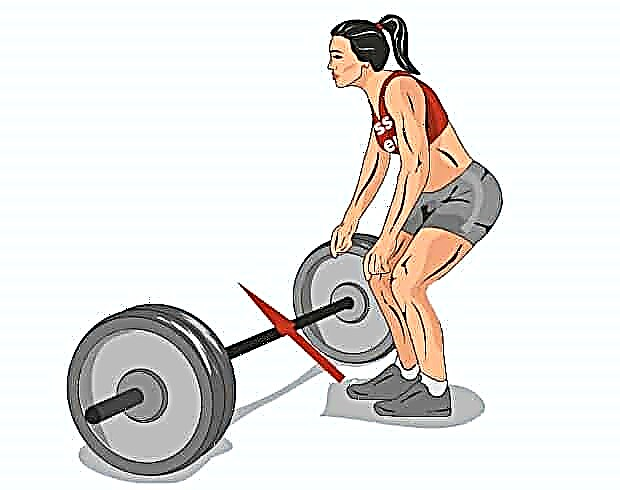Sooner or later, exercises with traditional equipment will bore even the most fanatically devoted adherent of "iron" sports. On the one hand, the soul asks for tough strength work, on the other, I don't want to go to the gym somehow. It is at such a moment in life that exercises with improvised equipment come to the rescue. In this article, we will look at tire exercises - they are very popular in CrossFit.
The essence of the exercises
For this kind of work, we need a tire from a truck, such as BELAZ, MAZ, etc. Tractor is also fine. And so, here we have brought this "inventory" from the nearest tire fitting - now what to do with it? There are a number of movements in which we can use the tire to develop the speed-strength qualities of our muscles:
- blows with a sledgehammer on a tire (requires additional purchase of a sledgehammer, weighing 4-8 kg);
- jumping on the tire cord, with the predominant involvement of the ankle joint. Simply put, you perform exactly the same jumps as on a rope - only without the rope and standing on the line of the tire. The load on the ankle will be fundamentally different, but more on that below;
- tire turning. This is an exercise that simulates deadlift, knee lift and press up at the same time. Here, except for the tire itself, no additional equipment is needed. However, you will need a sufficient amount of free space, at least commensurate with the two sizes of the tire you are using; this movement with a tire is often used in crossfit complexes;
- jumping on the tire. In general, it is not necessary to use a tire for this exercise; you can jump on anything. But if you decide to perform a circuit training, obviously, you need to spend as little time as possible to move between the shells - performing a complex with a tire, it will be logical to jump on it;
- farmer's walk with a tire. Ideally, it will require some "modernization" of the tire, namely, making 4 holes in the cord, threading handles (preferably cloth) through them. Without this, it is also quite possible to perform a "walk", but you will have to hold the tire with a reverse grip, which can be very traumatic for your shoulder and elbow joints. This option is only possible when using relatively small tires and it is strongly recommended to carry it out with gloves to protect the fingers;
- press up one end of the tire. A tire of considerable weight and diameter will be required. Plus, any point of support, so that the opposite segment of the tire being lifted does not move;
- back to the need to modify the tire with a pair of cloth handles. If this condition is met, and also provided that the diameter of the inner hole is sufficient, with the help of the tire, you can perform two more movements - the pull of the tire to the belt and the deadlift “in the well”, using the same tire.
If you have less than 2-3 years of serious strength training behind you (or less than 4-5 not very serious) - do better on horizontal bars and parallel bars, in addition to the loads in the gym. This recommendation is due to the fact that when performing exercises with uncomfortable weights, which include the tire, you need to have a well-developed muscular feeling, be able to redistribute the load from small muscle groups to large ones, and have a well-established technique for performing exercises with a barbell and dumbbells. Otherwise, the risk of injury increases exponentially.

What muscles are being trained?
As, probably, it was possible to understand from the previous section, large muscle masses can be trained with the tire - the back, legs, upper shoulder girdle.
It is the development of the upper shoulder girdle that is a feature of the tire press (as well as tire edging). With this kind of work, you do not use isolated muscles: the pectorals, deltas, triceps and biceps of the shoulder work synchronously and fatigue in about the same degree. By the way, here's a huge plus of exercise with a tire - it teaches your body to work well, improves intermuscular coordination and, accordingly, increases your strength potential by improving that very intermuscular coordination.
Types of exercises and their technique
Conventionally, exercises with a tire can be divided into two large groups: some require additional equipment, or a certain "modernization" of the tire, others do not. Let's start with the first group.
Tire and sledge hammer exercises
These are the most popular exercises in this group.
- Sledgehammer blows on the tire from the left-hand rack. Starting position: standing in a left-sided stand, the right hand is located on the handle of the sledgehammer slightly higher than the left and is the leading one. Without changing the position of the legs, we bring the sledgehammer, additionally turning the body to the right. With the combined muscular effort, we twist the body, due to the powerful combined tension of the muscles of the chest and abdominal muscles. The arms work exclusively as a transmission link between the body and the head of the sledgehammer. We deliver a powerful blow to the tire's lining. You can hit flat, you can - in the usual way. When hitting flat, the cord will wear out more slowly.

- Sledgehammer blows on the tire from the right-hand rack. The technique is identical to that described above, adjusted for the specularity of the original position.
- Sledgehammer blows on the tire from the front strut. Here the starting position is somewhat different: standing, feet shoulder width apart. The knees are slightly bent. The leading hand changes after each next stroke. Otherwise, the technique is identical to that described in A.

© alfa27 - stock.adobe.com
- Work on the tire with a sledgehammer, holding the sledgehammer with one hand. In this case, the starting position may vary (see above). The handle of the sledgehammer is held only by the leading hand. At the same time, it is located as low as possible on the handle. The swing, in this case, turns out to be somewhat more amplitude. The non-working arm is placed freely along the body.
Farmer's walk

© theartofphoto - stock.adobe.com
We stand in the hole of the tire. Feet shoulder width apart. We bring the shoulder blades, lower the shoulders. The lower back is arched and fixed in this position. Due to bending in the knee and hip joints, we lower our hands to the handles mounted on the tire. We grasp them firmly, straighten up as we exhale, while not unbending the knees to the end - we maintain an easy angle in order to avoid excessive compression of the lumbar spine and hip joints. Keeping the position of the body, we go through the given distance in small steps - the leg of the leading leg is placed no further than the toe of the supporting leg.
Deadlift
In general, the technique of the exercise is similar to that of the barbell exercise. The difference lies in the position of the hands. Here they are located on the sides of the body. The exercise corresponds to the exercise of the starting position described in the farmer's walk. The only difference is that after lifting the tire, you will not need to go with it, but return it to its original position. And move on to a new repetition.
Another option for deadlift is when tires are put on the bar from the bar instead of pancakes. Further, they work with such equipment in the same way as with a conventional barbell.

Tire pull to belt
It is advisable to put some kind of elevation in the hole of the tire, such as a bollard for jumping. We stand on this dais. We bend the legs as much as possible at the knee and hip joints, the lower back is statically tense. We grab the handles with our hands. Straighten the knee and hip joints. Keeping a small bend angle at the knees, bend over to parallel with the floor. The arms are fully extended, the back is rounded. With a powerful effort we bring the shoulder blades together, bring the shoulder joints back, pull the elbows behind the back. We squeeze the muscles of the back. We smoothly lower the projectile to the starting position. The tire is a very inconvenient tool.
Doing the deadlift with it will make your stabilizer muscles work in a whole new way.

Shrugs with tire
The shrug technique is completely identical to the shrug technique with any other weights. It makes sense to use a tire shrug in conjunction with a tire pull, deadlift, or a farmer's walk.

Pull the tire towards you and behind you
To do this, a long (about 10-20 m) thick rope will have to be tied to one of the handles. If there are no handles, you can use the hook. We stand at the end of this rope, while it is stretched, and the tire is removed at a distance equal to the length of the rope. We pull the rope towards us, alternately changing the leading hand.

© PixieMe - stock.adobe.com
Another variation is pulling the tire behind you. To do this, turn our back to the wheel and walk away, holding the rope thrown over our shoulder until it is pulled tight. After that, slowly, smoothly go forward and pull the tied tire behind us. We try to avoid jerks.

Jumping on a tire line
The starting position can be the left, right, or front stand. Rhythmically unbending the ankle joint, keeping a small angle, we make low jumps. Upon landing, the cord absorbs the gift with the foot. The effect of the exercise is comparable to jumping rope, but much more beneficial in terms of the health of the ankle joints. And the load on the lower leg muscles turns out to be more significant, since for each next jump you need to push off, each time overcoming the resistance of the cruel cord.

© seventyfour - stock.adobe.com
Hopping on the tire
Starting position: standing facing the tire, feet shoulder-width apart. We bend the legs at the knee and ankle joints, bring the pelvis in parallel with the floor. With a sharp effort we straighten our legs, simultaneously pushing off the floor with both legs. After pushing off the floor, we immediately pull our knees up, and land with our feet on the edge of the tire. Then there are several options for continuing the exercise:
- straighten up, get off the tire, go to the next repetition;
- repeating the first movement, jump backwards, land on our feet, go to the next repetition;
- we jump into the hole of the tire, in a movement similar to that described at the beginning of this paragraph, we jump to the opposite edge of the tire, again push off from it with our feet, we land on the floor. We turn around to face the tire, move on to the next series of jumps.

Tire edging
Starting position: standing facing the tire. We bend the legs at the knee and hip joints. We put our fingers under the edge of the tire. We lay our chest on the edge of the tire, straighten our legs at the knees. When the tire has reached the level of the belt, we substitute the knee under the edge of the tire, push it up. We immediately take the edge of the tire onto the chest, putting our palms under it. We push the edge of the tire away from us, unbending the elbow, knee and hip joints so that the tire rolls over itself and falls. We take a few steps towards the tire. Let's move on to a new repetition.

Tire press
The tire lies on the floor, the edge farthest from you rests against a fixed support. Using the method described in the "tire turning" exercise, we bring the edge of the tire onto the chest. Further, with a powerful controlled effort, we unbend the elbow and shoulder joints, remove the edge of the tire over the head. We smoothly return the edge of the tire to its original position. Let's move on to the next repetition.

Exercise Tips
Exercises with a tire can be alternated with each other or diluted with any exercises with your own weight or using other sports equipment. It all depends on your imagination, preparedness (it should not be lower than the "prepared" level - see above) and the availability of additional equipment. The main rule when drawing up any complex, including a complex with exercises with a tire, is to load all the muscles of the body in a balanced way during a session.
Do not forget about safety precautions, especially if you use a wheel of a very large size and weight, because it is enough for it to be easily injured.
Crossfit workouts with exercise
We bring to your attention several crossfit complexes containing tire exercises.











